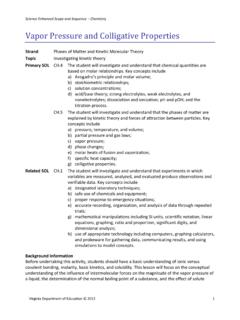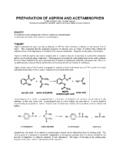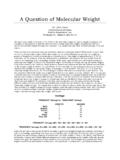Transcription of Colligative Properties of Foods - ENCYCLOPEDIA OF LIFE ...
1 food ENGINEERING Vol. I - Colligative Properties of Foods - Welti-Chanes, J., Tapia, M. S., Alzamora, S. M., Palou, E. and L pez-Malo, A., Vergara-Balderas, F. Colligative Properties OF Foods . Welti-Chanes, J. Department of Chemistry and Biology and Department of Chemical and food Engineering, Universidad de las Am ricas, Puebla, M xico Tapia, M. S. Instituto de Ciencia y Tecnolog a de Alimentos, Universidad Central de Venezuela, Venezuela Alzamora, S. M. Departamento de Industrias, Facultad de Ciencias Exactas y Naturales, Argentina Palou, E. and L pez-Malo, A. and Vergara-Balderas, F.
2 Departamento de Ingenier a Qu mica y Alimentos, Universidad de las Am ricas, S. TE S. Puebla, Mexico R. AP LS. Keywords: Colligative Properties , freezing-point depression, boiling point, osmotic pressure . C EO. Contents 1. Introduction 2. Ideal Solutions E . H. Thermodynamic Properties of Truly Ideal Solutions Ideal Solid-liquid Solutions PL O. 3. Colligative Properties M SC. Depression of the Freezing Point Basic Concepts Applications to Foods Elevation of the Boiling Point SA NE. Basic Concepts Applications to Foods Osmotic pressure U. Basic Concepts Applications to Foods Glossary Bibliography Biographical Sketches Summary The analysis of food behavior as a system affected by its own composition and external conditions is interesting for the analysis and design of preservation processes.
3 The description of food as an aqueous solution and the application of fundamental chemical thermodynamic concepts to this type of solution allow the understanding of certain food Properties related to composition, as in the Colligative Properties . These Properties , based on the fundamentals of phase equilibrium, comprise the depression of freezing ENCYCLOPEDIA of Life Support Systems (EOLSS). food ENGINEERING Vol. I - Colligative Properties of Foods - Welti-Chanes, J., Tapia, M. S., Alzamora, S. M., Palou, E. and L pez-Malo, A., Vergara-Balderas, F. point, elevation of boiling point, and osmotic pressure .
4 The magnitude of such Properties is affected by the quali- and quantitative composition of food , which in turn modifies the behavior of food during processes, such as in freezing, vaporization, osmotic dehydration, and membrane applications, among others. For this reason, it is important to know the theoretical concepts that can aid in understanding the Colligative Properties , as well as the application of these concepts to practical aspects of processes, such as those already mentioned. 1. Introduction Most food systems can be studied as aqueous solutions. Therefore, it is possible to describe their thermodynamic behavior through the theoretical concepts applied to the ideal, as well as to real solutions.
5 Such behavior mainly depends on the type, quantity, and interaction of the non-volatile solute or solutes contained in the food , in relation to the most important solvent in food , water. At first, solute-water interactions in Foods S. TE S. affect certain Properties , such as vapor pressure , chemical potential, and activity R. AP LS. coefficients, but these in turn act on other Properties , among which, the so-called Colligative Properties ( , freezing point depression, elevation of boiling point, and modification of osmotic pressure ). C EO. Such Colligative Properties are of interest to food engineers for the design and analysis of dehydration processes ( , concentration and osmotic dehydration), and freezing, and change magnitude according to the type of food and solute or solutes present within.
6 In this way, the thermodynamic description of Foods , and particularly the E . analysis of their Colligative Properties , is important and, in principle, can be determined H. based on the theoretical concepts describing solution behavior, which may or may not PL O. be ideal. For this reason, before studying in detail the above- mentioned Properties it is recommended that one have a general view of what an ideal solution is, including a M SC. thermodynamic description. 2. Ideal Solutions SA NE. A two-component ideal solution can be defined as one in which the total pressure (P) of the gaseous phase generated from this is U.
7 P = X1 P1 + X 2 P2 (1). where X1 and X 2 are the mol fraction of components 1 and 2 of the mixture, with n1. and n2 as the moles of each to a total of n moles ( n = n1 + n2 ) . In the case of binary mixtures of liquids, the ideal behavior is complied with, since a greater similarity exists between the chemical structures of both compounds. According to Equation (1), it is obvious that Raoult's law describes the denominated partial pressure of each component i ( Pi ) of the gaseous phase in equilibrium with the liquid phase: ENCYCLOPEDIA of Life Support Systems (EOLSS). food ENGINEERING Vol.
8 I - Colligative Properties of Foods - Welti-Chanes, J., Tapia, M. S., Alzamora, S. M., Palou, E. and L pez-Malo, A., Vergara-Balderas, F. Pi = X i Pi (2). where Pi is the vapor pressure of pure component i at temperature T . On the other hand, if it appears that equilibrium between the solution and the gaseous phase generated exists, and if the latter behaves as a perfect gas, then it is possible to apply the chemical potential concept described in the topic Thermodynamics in food Engineering (TFE): i( sol ) = i( g ) = iD( g ) + RT ln Pi (3). which represents the chemical potential equality of the component, i , in the solution ( ( ) ) and the vapor ( ( ) ) thereby released, in terms of the standard chemical S.
9 I sol i g TE S. potential of the vapor ( ( ) ) and of the component's partial pressure . D. R. AP LS. i g A combination of Equations (2) and (3) to define the chemical potential of component i C EO. in the solution leads to i( sol ) = iD( g ) + RT ln Pi + RT ln X i (4).. E . In this equation, the term iD( g ) + RT ln Pi is a constant at each temperature and H.. PL O. represents the chemical potential of i as a pure liquid i (1) . Hence, ( ). M SC. i( sol ) = i (1) + RT ln X i (5). SA NE. This equation is used to describe the solution behavior in terms of the concentration of each component.
10 Additionally, if the solution participates in processes in which the pressure is maintained near 1 atm and pressure changes are very small, then the U. chemical potential of component i as a pure liquid will tend to equal the potential of component i in liquid form, and under standard conditions (1 atm of pressure ), this means: i (1) = iD(1) . Thus, Equation (5) becomes i( sol ) = iD(1) + RT ln X i (6). This equation is applied to the denominated truly ideal solution, and is particularly important in describing the behavior of many Foods . Thermodynamic Properties of Truly Ideal Solutions If every component in a mixture behaves according to Equation (6), in all the ENCYCLOPEDIA of Life Support Systems (EOLSS).

















